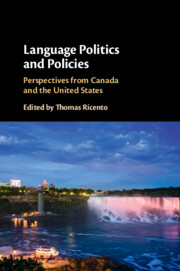Book contents
- Language Politics and Policies
- Language Politics and Policies
- Copyright page
- Dedication
- Contents
- Figures
- Tables
- Contributors
- Preface
- Contributor Personal Statements
- Introduction
- Part I Theoretical Orientations
- Part II The United States Context
- 5 Disciplining Bilingual Education
- 6 Measured Multilingualism
- 7 The Rise, Fall, and Rebirth of Bilingual Education in California and the Ongoing American Dilemma
- 8 Language Policy Conflicts
- 9 Indigenous Language Movements in a Settler State
- 10 The Politics of Language Education Policy Development and Implementation
- Part III The Canadian Context
- Index
- References
8 - Language Policy Conflicts
New York City’s Efforts to Expand Bilingual Education Amidst English-Only Pressures
from Part II - The United States Context
Published online by Cambridge University Press: 18 July 2019
- Language Politics and Policies
- Language Politics and Policies
- Copyright page
- Dedication
- Contents
- Figures
- Tables
- Contributors
- Preface
- Contributor Personal Statements
- Introduction
- Part I Theoretical Orientations
- Part II The United States Context
- 5 Disciplining Bilingual Education
- 6 Measured Multilingualism
- 7 The Rise, Fall, and Rebirth of Bilingual Education in California and the Ongoing American Dilemma
- 8 Language Policy Conflicts
- 9 Indigenous Language Movements in a Settler State
- 10 The Politics of Language Education Policy Development and Implementation
- Part III The Canadian Context
- Index
- References
Summary
The focus of this chapter is on conflicts between federal, state, and city language education policies and how these are navigated in New York City schools. US language education policies at the federal government level have been largely restrictive of languages other than English in school, particularly due to required high-stakes testing in English, which directly caused the elimination of bilingual education programs in New York City schools. In an effort to redress this loss in bilingual programs, New York State has in recent years adopted policies that actively promote bilingual education, while neither contesting nor significantly changing competing policies that actively assert English dominance. Research in one of these new bilingual education programs in New York City highlights these tensions, showing how current policies are mismatched to the needs of local communities. Our qualitative research investigates the expansion of dual language bilingual education (DLBE) in New York City public schools through a focus on a newly-opened Hebrew DLBE program in a public middle school. In this chapter, we share findings from classroom observations, interviews with school administrators, teachers, students and their families, as well as state, city, and school policy documents.
Keywords
- Type
- Chapter
- Information
- Language Politics and PoliciesPerspectives from Canada and the United States, pp. 153 - 172Publisher: Cambridge University PressPrint publication year: 2019
References
- 3
- Cited by

